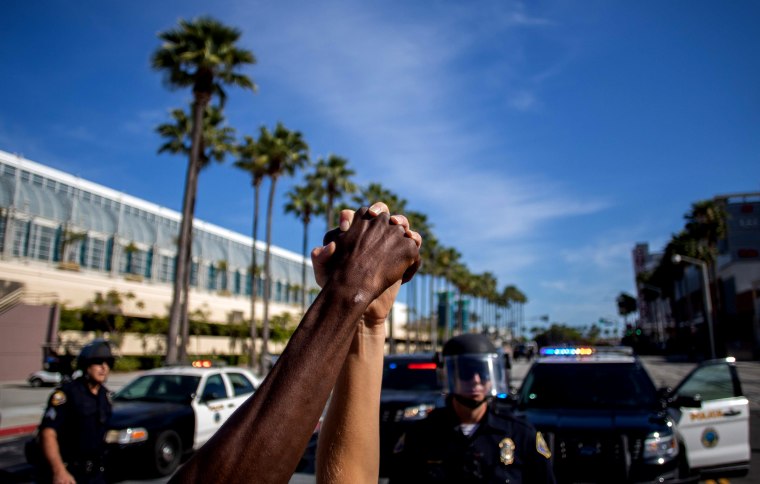It started with a tweet.
On Friday, as protests against police brutality roiled the nation, members of the Brooklyn Community Bail Fund noticed a request on Twitter asking that people donate to the nonprofit as a way to support the demonstrations.
Within 24 hours, more than 50,000 individuals had donated $1.8 million to support the fund, Peter Goldberg, the executive director of the Brooklyn Community Bail Fund, said in a statement to NBC News.
“It’s a literal investment in the movement to dismantle the racist, violent systems that oppress black and brown people, low-income communities, and immigrants,” Goldberg said “It also shows a real hunger for change and the many different ways we can achieve it by working together.”
In addition to the more than 250 protests, rallies and vigils across the country that sprang up following the death of George Floyd, a black man who was killed by Minneapolis police on May 25, an organic donation-matching movement has flourished on social media.
Fundraising experts said there are myriad reasons that viral movements are effective in raising money, including the power of a call to action, the feeling of social accountability and an emotional appeal.
On social media, a variety of nonprofits and organizations have been the recipients of the donation-matching chains, but it appears bail funds have been the primary choice for many looking to show their support for the fight against police brutality and racial inequality.
The chains happen like this — one person tweets a screenshot of a donation they’ve made, typically between $20 and $50. Along with the screenshot, the tweeter will ask if anyone can match their donation. Typically, a person will retweet the initial tweet with a screenshot of their own donation and confirmation that the amount has been “matched.” And the chain builds from there.
The funds, such as The Minnesota Freedom Fund, one of the groups at the heart of the donation-matching over the weekend, “pays criminal bail and immigration bond for those who cannot afford to” in an effort to “end discriminatory, coercive and oppressive jailing,” according to a description of the non-profit.
Representatives of the Minnesota Freedom Fund didn't respond to NBC News' multiple requests for comment, but tweeted that they were overwhelmed.
“Wow. So much support from all over the country + the world! We are overwhelmed with gratitude for everyone who has provided support at this time,” the fund tweeted on Thursday.
Floyd’s death in Minneapolis may have sparked the national protests, but Minnesota is far from the only state with a bail-assistance fund receiving major support on social media.
On Friday, at least 200 people who were among protests in New York City were arrested. It was the same day Goldberg’s team noticed the tweet directing others to donate to their fund.
“We saw that support echoed in a flood of posts on social media with screenshots of donation receipts from bail funds, community-based organizations, and grassroots mutual aid groups -- powerful evidence that people are taking steps to hold themselves, their friends, and their networks accountable for addressing racism and injustice,” Goldberg said.
In addition to everyday donors, celebrities like Chrissy Teigen, Janelle Monáe, Don Cheadle, Steve Carell, and Seth Rogen have tweeted their contributions to organizations and bail-aid funds in support of the protesters.
Aside from donating, people have also found creative ways to financially help the protesters. Some have offered to send money to those who are out in the crowds if they get stranded or need help.
“If you get stranded in LA, DM me. I’ll Venmo you uber money to get home,” tweeted television writer Jack Moore, who appeared to send money to multiple recipients, on Sunday.
Ashley Whillans, an assistant professor at Harvard Business School who holds a doctorate in social psychology and has researched how and why people decide to make charitable contributions, said the influx of donations stemming from a social media is reminiscent of the ALS Ice Bucket Challenge, which succeeded because it was a call to action and offered a feeling of social accountability.
“Seeing people in your social network taking action in their own way, I think a similar logic applies here, where you do say I don’t want to be the person who doesn’t do it, especially as it picks up momentum,” Whillians said.
Additionally, Whillans said that people sometimes have an aversion to giving if they think other people aren’t actually donating or they don’t know how much. In the case of the current matching trend on Twitter, the attachment of a screenshot could help people to overcome that aversion, Whillans said.
“You have people going out on social media, actually showing where they’re donating and how they’re donating and this transparency could inspire other people to take action as well,” she said.
Ultimately, the donation movement on social media is a way for people who are watching the protests unfold to feel a small piece of control by engaging in a tangible form of helping, when so much feels out of control.
“It is a very specific, tangible, concrete way we can take some of this anxiety and almost, like, hopelessness that would be easy to feel just by watching the news and turn it into an opportunity to help someone,” Whillans said.


